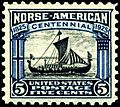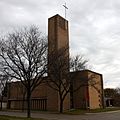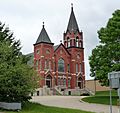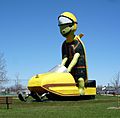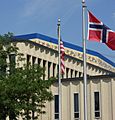Norwegian Americans facts for kids
| Total population | |
|---|---|
| 4,642,526 1.5% of the US population |
|
| Regions with significant populations | |
| Midwest | 2,273,683 |
| West | 1,552,462 |
| South | 545,699 |
| Northeast | 266,881
|
| 868,361 | |
| 466,469 | |
| 412,177 | |
| 410,818 | |
| 199,154 | |
| 173,640 | |
| 171,745 | |
| 164,676 | |
| 129,081 | |
| 124,618 | |
| 119,164 | |
| 117,444 | |
| 113,543 | |
| 92,796 | |
| 90,425 | |
| Languages | |
| English, Norwegian | |
| Religion | |
| Christianity (predominantly Evangelical Lutheran Church in America, Lutheran Church–Missouri Synod, Catholicism) Judaism (predominantly Orthodox Judaism and Reform Judaism), Atheism | |
| Related ethnic groups | |
| Norwegians, Norwegian Canadians, Scandinavian Americans, Danish Americans, Swedish Americans, Norwegian Australians, Norwegian New Zealanders, other | |
Norwegian Americans are people in the United States who have family roots in Norway. Many Norwegian immigrants came to the U.S. in the late 1800s and early 1900s. Today, about 4.6 million Americans identify as having Norwegian heritage. This makes them a big part of the American population.
Contents
Why Norwegians Came to America
Seeking New Opportunities
Many Norwegians left their homeland for America. They were looking for a better life. Norway had limited farmland and a growing population. This made it hard for many families to find land or jobs.
The Promise of America
America offered a lot of hope. The Homestead Acts of 1862 were a big draw. These laws allowed settlers to claim free land in the American West. This was a huge chance for families to own their own farms.
Early Norwegian Settlers
The first organized group of Norwegian immigrants arrived in 1825. They came on a ship called the Restauration. Cleng Peerson was a key leader in this early movement. He helped many Norwegians find their way to America.
Where Norwegian Americans Settled
Farming the Midwest
Most Norwegian immigrants settled in the Midwest. States like Minnesota, North Dakota, and Wisconsin became home to large Norwegian communities. The flat, fertile land reminded them of parts of Norway. It was perfect for farming.
Building New Communities
They often formed close-knit communities. These towns kept Norwegian traditions alive. They built churches and schools. Many towns still have strong Norwegian roots today. Minneapolis has one of the largest groups of Norwegians outside Norway.
Norwegian American Culture and Traditions
Language and Religion
Early immigrants spoke Norwegian. Over time, English became the main language. However, many still learn Norwegian. Most Norwegian Americans are Christian, especially Lutheran. Churches were important centers for their communities.
Food and Celebrations
Norwegian Americans enjoy many traditional foods. These include Kransekake, a special almond cake. They also celebrate Norwegian holidays. Syttende Mai (May 17th) is Norway's Constitution Day. It is a big celebration for Norwegian Americans. They often wear traditional clothes and have parades.
Keeping Heritage Alive
Many organizations work to preserve Norwegian culture. The Sons of Norway is one such group. They host events and teach about Norwegian history. Museums like the Vesterheim Norwegian-American Museum also share this rich heritage.
Notable Norwegian Americans
Many Norwegian Americans have made important contributions. They have excelled in many fields. These include politics, science, and the arts. Their hard work helped build America.
Images for kids
-
A 1925 U.S. postage stamp featuring the ship Viking honoring the 100th anniversary of Norwegian immigration.
-
Norwegian settlers in front of their sod house in North Dakota in 1898. Photo taken by John McCarthy and collected by Fred Hultstrand
-
A 1962 US postage stamp commemorating the centennial of the Homestead Act was issued. The image on the stamp is based on Norwegian settlers in front of their sod house.
-
A re-enactment of Norwegian farmers making head cheese in Wisconsin.
-
Kransekake cake decorated with small flags of Norway at the Olmsted County Fair in Rochester, Minnesota.
-
Norwegian-Hawaiian girl, 1909
-
The Distribution of Norwegian Americans according to the 2000 census.
-
30.8% of the population in the U.S. state of North Dakota is of Norwegian ancestry.
-
A map of the United States and Canada with number of Norwegian Americans and Norwegian Canadians in every state and province including Washington, D.C..
-
Minneapolis has the largest concentration of Norwegians outside Norway.
-
Our Savior's Lutheran Church in Norse, Texas, built in 1885.
-
Lutheran church on Sletta, Radøy, built 1908 to 1922 in Brampton, North Dakota, and moved as a gift from Norwegian emigrants in the United States and Canada in 1997.
-
The Norwegian Lutheran Memorial Church of Minneapolis. It is one of two American churches still using Norwegian as a primary liturgical language, the other being Minnekirken in Chicago, Illinois.
-
Christ Church Lutheran in Minneapolis, built in 1948.
-
This patriotic fantasy in flag was given to the American friend, violinist and composer Ole Bull (1818–1880) as a gift from The New York Philharmonic Society. The flag of Norway has been the U.S. star banner that the union mark instead of the Norwegian-Swedish "Sildesalaten".
-
Northwood, North Dakota, has the second highest percentage of Norwegian American ancestry in the United States, 55.5%.
-
Moorhead, Minnesota is the city with the highest percentage of Norwegians with a population over 30,000.
-
Little Norway is a tourist attraction and living museum of a Norwegian village located in Blue Mounds, Wisconsin. It is listed on the National Register of Historic Places.
-
Petersburg was founded by the Norwegian immigrant Peter Buschmann. Known for its strong Norwegian traditions and nicknamed "Little Norway".
-
Flags of the United States and Norway at the Sons of Norway Building on Lake Street in Minneapolis, Minnesota.
-
The Westby Norseman.
-
Front of the Vesterheim Norwegian-American Museum main building in Decorah, Iowa.
-
Vesterheim Norwegian-American Museum, the oldest and most comprehensive museum in the United States devoted to a single immigrant ethnic group. The collection contains over 24,000 artifacts reflecting the experience of Norwegian Americans.
-
St. Olaf Kirke, constructed in 1884, in Cranfills Gap, Texas.
-
Norwegian Lutheran Church in Irwin, Iowa, in 1941.
-
Norwegian Lutheran Memorial Church in Minneapolis, Minnesota, built in 1922.
-
Chapel in the Hills, a replica of an historic stave church, consecrated in 1969 in Rapid City, South Dakota.
-
Historic Norwegian church in Herkimer County, New York
-
Founded in 1861 by Norwegian immigrants, Luther College is a four-year, residential liberal arts institution of the Evangelical Lutheran Church in America, located in Decorah, Iowa.
-
Concordia College in Moorhead, Minnesota is a private, four-year liberal arts college of the Evangelical Lutheran Church in America (ELCA), founded in 1891.
See also
 In Spanish: Inmigración noruega en los Estados Unidos para niños
In Spanish: Inmigración noruega en los Estados Unidos para niños


